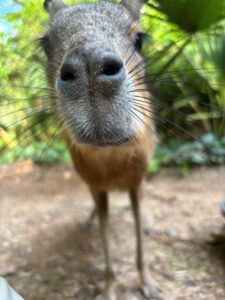It takes a village – Species Survival Plans
Hi all! My name is Sarah Fredrickson, and I’m a Keeper III in our Ambassador Animals Department. I’m specifically a Primary Keeper in what we call our Outback Station area, which is mostly known for our herd of goats and sheep that we invite guests to come interact with in the Contact Yard. What most don’t know, however, is that we also care for the Patagonian maras – the weird little rabbit-looking creatures that live across the path from Bob the tiger!
 Not only do I care for our two maras, named Reuben and Rachel, but I also help care for the whole population of Patagonian maras in AZA zoos. No, I’m not flying around the country on the most insane work schedule of all time – I’m serving as the Vice-Coordinator of their Species Survival Plan. When most people think of Species Survival Plans (SSPs for short), they usually think of the iconic, charismatic megafauna species such as giant pandas, African elephants, and Bengal tigers. However, there are actually nearly 500 SSPs being managed by the Association of Zoos and Aquariums. They are in place for everything from species of small fish, all the way up to the big guys that I mentioned previously, and everything in between.
Not only do I care for our two maras, named Reuben and Rachel, but I also help care for the whole population of Patagonian maras in AZA zoos. No, I’m not flying around the country on the most insane work schedule of all time – I’m serving as the Vice-Coordinator of their Species Survival Plan. When most people think of Species Survival Plans (SSPs for short), they usually think of the iconic, charismatic megafauna species such as giant pandas, African elephants, and Bengal tigers. However, there are actually nearly 500 SSPs being managed by the Association of Zoos and Aquariums. They are in place for everything from species of small fish, all the way up to the big guys that I mentioned previously, and everything in between.
As Vice-Coordinator, my job is to help the Coordinator oversee the population of Patagonian maras that are held in AZA-accredited zoos. Part of our role is receiving inquiries from zoos wanting to add maras to their animal collection and reaching out to facilities that already have maras to see if they have any that they could send out. Another part of our role is playing matchmaker and moving animals between zoos for breeding opportunities. It’s important to make sure our population under human care is genetically healthy, so this is actually a lot more complicated than you’d think!
Each SSP has something called a studbook, which is not only a record of every individual and where they live, but also tracks their relations. In a way, the studbook acts like a combination of an ancestry app and a dating app. By paying attention to the genetics, we can ensure that our breeding recommendations will lead to happy, healthy little mara pups! Which, by the way, in case you’ve never seen one, I fully encourage you to Google what a baby Patagonian mara looks like. They are aggressively adorable.
Without Species Survival Plans in place, with the partnership between zoos and aquariums, there are so many species that not only wouldn’t exist under human care to serve as ambassadors for their wild cousins, but wouldn’t exist period. SSPs have truly been a saving grace for many species, providing a safe space to hold a population with the hope of releasing some individuals back into their native range. In the meantime, the individuals in zoos and aquariums have the very important job of helping educate our guests about their species and how to help them.
Sarah Frederickson
Keeper III, Ambassador Animals
(photos: Sarah F.)

Connect With Your Wild Side #onlyzooatl